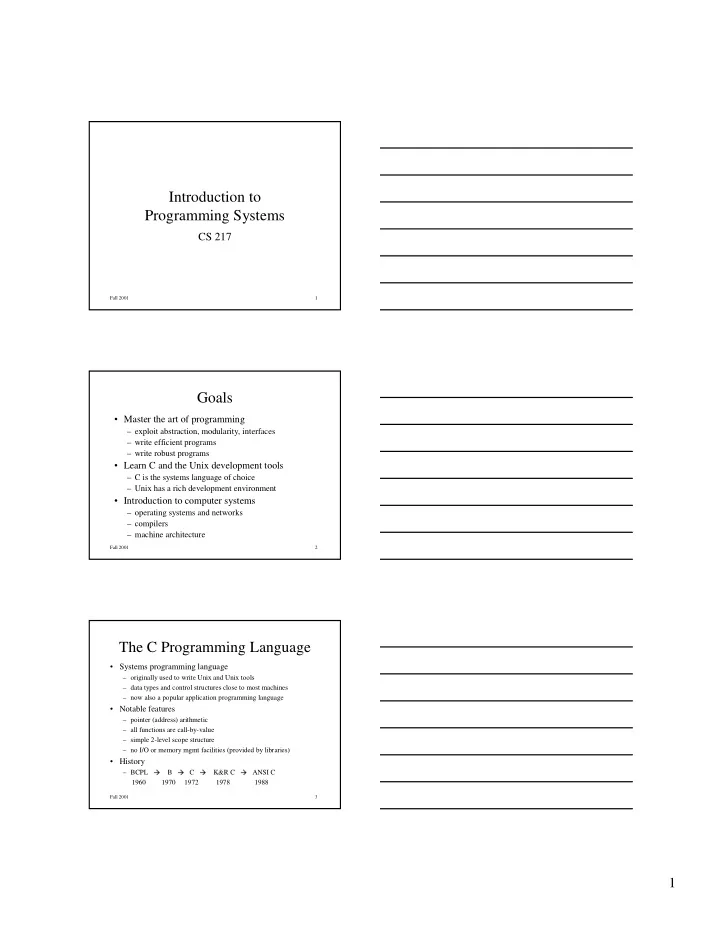

� � � � Introduction to Programming Systems CS 217 Fall 2001 1 Goals • Master the art of programming – exploit abstraction, modularity, interfaces – write efficient programs – write robust programs • Learn C and the Unix development tools – C is the systems language of choice – Unix has a rich development environment • Introduction to computer systems – operating systems and networks – compilers – machine architecture Fall 2001 2 The C Programming Language • Systems programming language – originally used to write Unix and Unix tools – data types and control structures close to most machines – now also a popular application programming language • Notable features – pointer (address) arithmetic – all functions are call-by-value – simple 2-level scope structure – no I/O or memory mgmt facilities (provided by libraries) • History – BCPL B C K&R C ANSI C 1960 1970 1972 1978 1988 Fall 2001 3 1
Systems Software Compilers & Assemblers Application Programs Linker/Loader Command Shell Development Tools debugger, profiler Commands & Libraries editor, version control Libraries standard, math, … OS Kernel Process Management Virtual Memory File System Machine Architecture Network Subsystem Fall 2001 4 Difficult Lessons • Program specifications are ambiguous (buggy) – code you write (your assignments) – code you use • Programming is mostly about writing robust code; the algorithms are often simple • Systems programming cannot be rushed Fall 2001 5 Course Details • Lectures – www.cs.princeton.edu/courses/cs217/ • Precepts – work through programming examples – demonstrate tools (gdb, makefiles, emacs, …) • Assignments – six total (yes, you implement a shell) – 2/3rds of your grade Fall 2001 6 2
Course Details (cont) • Textbooks – C: A Reference Manual. Harbison & Steele. – SPARC Architecture, Assembly Language Programming, and C. Paul. – C Interfaces and Implementations. Hanson. – Programming with GNU Software. Loukides & Oram. Fall 2001 7 Course Details (cont) • Facilities – CIT’s arizona cluster – SPARC lab in Friend 016 – Your own laptop ssh access to arizona run GNU tools on Windows run GNU tools on Linux Fall 2001 8 Programming Style • Variable names, indentation, structure,… • Example style guide www.cs.princeton.edu/courses/cs217/style.ps • Who reads your code? – compiler – other programmers • Which one cares about style? • Macho programmer != good programmer – avoid trying to be too clever Fall 2001 9 3
Programming Style (cont) • Names – use descriptive names for globals and functions e.g., elementCount – use concise names for local variables e.g., i (not arrayindex ) for loop variable – use case judiciously e.g., PI , MAXLINE (reserve for constants) – use consistent style for compound names e.g., printword , PrintWord , print_word – use module prefixes to distinguish names e.g., Strset_T , Strset_add Fall 2001 10 Programming Style (cont) • Layout and indentation – use white space judiciously e.g., to separate code into paragraphs – use indentation to emphasize structure use editor’s autoindent facility – break long lines at logical places e.g., by operator precedence – line up parallel structures alpha = angle(p1, p2, p3); beta = angle(p1, p2, p3); gamma = angle(p1, p2, p3); Fall 2001 11 Programming Style (cont) • Control structures if (x < v[mid]) if (x < v[mid]) high = mid – 1; high = mid – 1; else if (x < v[mid]) else if (x > v[mid]) low = mid + 1; low = mid + 1; else else return mid; return mid; implement multiway branches with if … else if … else emphasize that only one action is performed avoid empty then and else actions handle default action, even if can’t happen (use assert(0) ) avoid continue ; minimize use of break and return avoid complicated nested structures Fall 2001 12 4
Programming Style (cont) • Documentation – comments should add new information i = i + 1; /* add one to i */ – comments must agree with the code – comment procedural interfaces liberally – comment algorithms, not coding idiosyncracies – master the language and its idioms; let the code speak for itself Fall 2001 13 Process Memory 0 program instructions text } data global variables bss heap dynamic (malloc’ed) data local/tmp variables (frame per procedure) stack 0xffffffff Fall 2001 14 Process Memory (cont) int i; bss int j = 74; data main() { char *p; stack p = malloc(8); heap … } Fall 2001 15 5
Software is Hard “What were the lessons I learned from so many years of intensive work on the practical problem of setting type by computer? One of the most important lessons, perhaps, is the fact that SOFTWARE IS HARD. From now on I shall have significantly greater respect for every successful software tool that I encounter. During the past decade I was surprised to learn that the writing of programs for TeX and Metafont proved to be much more difficult than all the other things I had done (like proving theorems or writing books). The creation of good software demands a significantly higher standard of accuracy than those other things do, and it requires a longer attention span than other intellectual tasks.” Donald Knuth, 1989 Fall 2001 16 6
Recommend
More recommend